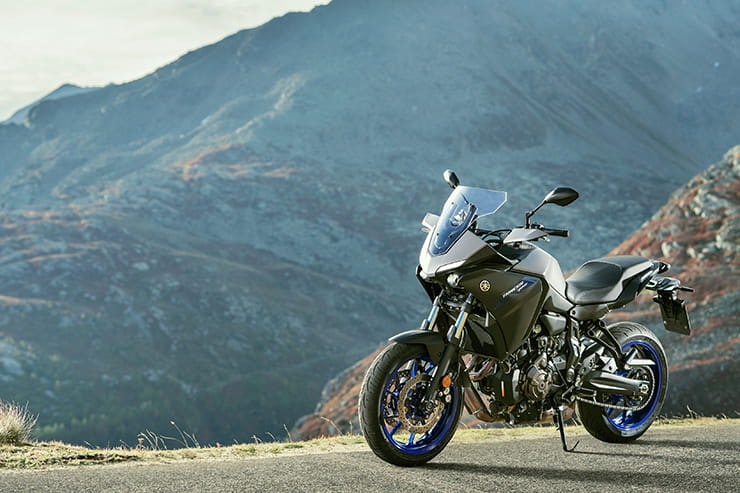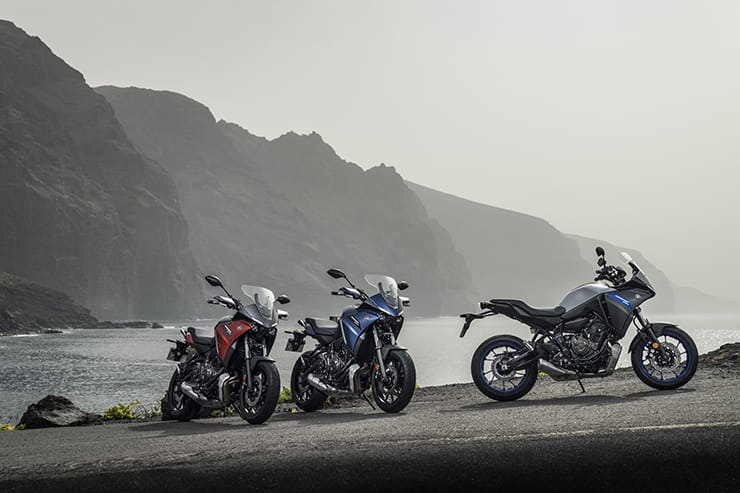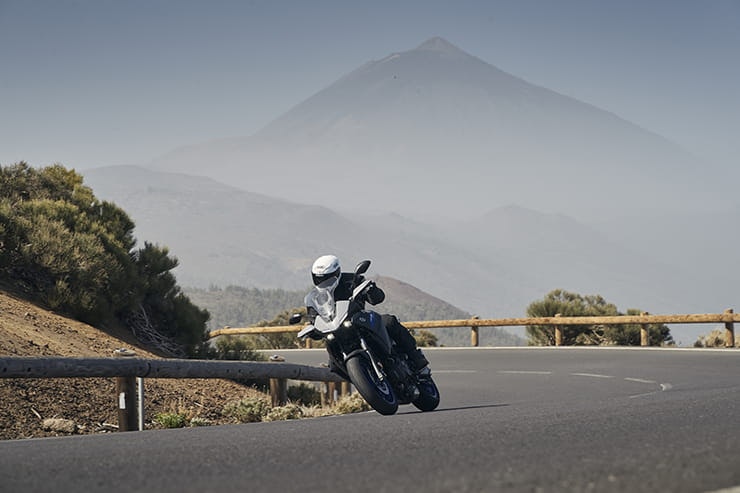Yamaha Tracer 700 (2020) - Review
By Steve Rose
BikeSocial Publisher
02.03.2020
"Yamaha’s brilliant new Tracer 700 gets funky new styling, Euro 5 emissions and improved suspension to become even more brilliant. Is it the bike of 2020? That’s a big claim for a 74bhp all-rounder, but we think it’s justified."
The comfort and versatility
The power delivery and engine performance
The confident handling
Screen could be better
Cruise control and a centre stand would make a better tourer
Panniers are wider than the mirrors
Some bikes become bigger than just ‘another great motorcycle’. Every generation has a few machines that define motorcycling in that time. Bonnevilles, Fizzies, CB750s, LCs, GSX-Rs, 916, Bandit or GS – I don’t have to name the manufacturer or even the full model name you know what I’m referring to.
Yamaha’s original Tracer 700 should have been the one for today. All the brilliance, value-for-money and mischievous attitude of the of the MT-07, with some added practicality and all-round ability. If you squinted hard enough it looked a little bit like an adventure bike, but without the pretence at any off-road capability. Not surprisingly, Yamaha sold plenty of Tracer 700s, but back at HQ they were slightly disappointed that it hadn’t been even more. The ambition for the twin-cylinder Tracer was that it would appeal to younger riders wanting a bike they could commute on, loon about on and head off for a long weekend away on too.
So for the 2020 revamp, Yamaha have given the Tracer 700 a radical new look, fixed the handful of niggles, brought the emissions to Euro 5 standard and turned what was already a very good motorcycle into an exceptional all-rounder that deserves to become the Bandit 600 or CBR600F of its day.
The 2020 Tracer 700 might not have the dark side, rude boy image of the MT-07, or the dusty credibility of the Ténéré 700. Sports touring might not have the full-on adventurist machismo, but when your sports tourer is this lightweight, manageable and god value too, it becomes so much more.
Looks like an R1 crossed with a TDM900, rides like a sporty all-rounder, yours for £89 a month
2020 Yamaha Tracer 700 Price
RRP is £7799, which becomes £7945 when you add otr charges. It’s a few hundred quid up on last year (before allowing for the deals on remaining 2019 stock) and Yamahas PCP deal allows 36 monthly payments of £89 with a £2500 deposit and £3195 final payment.
Comparisons with other bikes are harder than you’d think. The sporty middleweight all-rounder market is pretty niche.
You might be considering BMWs F750GS at a push or Honda’s NC750X. Both are as good at the practical, all-round stuff, but neither has the same sense of fun and both weigh at least 35kg more in road trim. Perhaps a Suzuki V-Strom 650 because you don’t really expect to take it off road or the standard version of KTMs 790 Adventure.
All are more expensive than the Tracer, some have more electronics, few have the same mix of performance, comfort and value for money.
Bodywork is slimmer than before but equally effective. LED headlights are more powerful and much lighter than conventional units
2020 Yamaha Tracer 700 Styling, finish and riding position
The biggest change for 2020 is a new look that strongly resembles Yamaha’s R-series sports bikes. It might be just me, but from the front there’s also a sort-of latter-day tribute to the TDM900 too. Yamaha claim the bodywork is slimmer than before but still gives the same wind protection. Switching the headlights to LED projectors improves performance and helps offset the additional mass required by the Euro 5 emissions equipment.
The riding position has been tweaked with slightly wider (34mm wider) handlebars, and an easily adjustable two-position screen. There’s 6.5cm of screen adjustment, although I found it hard to tell any difference between the two positions other than the higher one was noisier.
Fit and finish is very good for a bike in this price bracket. The plastics look good in all three colour options.
689cc, twin-cylinder motor has torque and top end power, plus that lovely crossplane crank growl
2020 Yamaha Tracer 700 Power and torque
The Tracer is the first of Yamaha’s 689cc CP2-engined bikes to be ready for the Euro 5 emissions regulations. CP2 stands for Crossplane crank (Yamaha’s take on funky cylinder firing orders to give an engine extra traction and character too) with two cylinders.
Making it Euro 5 compliant involved revisions to the valve gear, airbox, fuelling and ignition mods and some gearbox tweaks too. There’s a new catalytic converter behind the exhaust down pipes, which allows the catalyst to heat up faster and work more efficiently.
Power and torque figures remain the same 74bhp and 50lb-ft as the previous model. Don’t underestimate what a massive job it was for Yamaha’s engineers to achieve that and pass Euro 5 without increasing the capacity or changing the power characteristics. Yamaha also claims the same fuel consumption as the old bike despite increasing the rear drive sprocket from 43 to 45 teeth - something that makes the acceleration sharper, but also means more revs per mph when cruising. Except, we suspect they’ve changed the internal gear ratios too because top gear cruising still feels as relaxed as the old bike.
Stubby exhaust can keeps the back-end styling clean. The silencing all happens in the big metal box under the engine.
2020 Yamaha Tracer 700 Engine, gearbox and exhaust
Yamaha’s CP2 motor is just simply brilliant. You could put this motor in a Harley, drop it on Valentino’s foot and crush Guy Martin’s fingers with one and motorcycling would still love it.
In use, it feels lively, crisp and willing. This motor can get a wiggle on when overtaking in a gear too high, but it can also accelerate hard out of corners with a broad enough rev range to leave it in the same low gear through long twisty sections. When you need to potter through traffic it’ll do that too and cruise without vibes or buzziness on the motorway. For an engine to be so quick, so much fun, so flexible and still average 58mpg on a press launch, is stunning. For that motor to be fitted in a bike that pretty much everyone with a job and a credit rating can afford is the answer in a nutshell to why Yamaha has sold so many CP2 powered bikes.
The engine is essentially unchanged bar the revisions for Euro 5. As a rider the most noticeable differences are the extra urgency when accelerating from the change in gearing and that every revised generation of fuel injection seems to get smoother, more flexible and easier to use.
The gearchange is positive, but slick too through all six ratios and neutral is always easy to find. There’s no quickshifter, but you don’t miss it. Changing up without the clutch needs a few miles to get the knack, otherwise it can feel a bit stiff.
The exhaust note allows a bit of crossplane-growl to seep past the Euro 5 restrictors, but the Tracer is mostly quiet enough to get away with riding it like you want to without attracting unwanted attention. That’s a good thing, by the way.
Tank holds 17 litres and should average 60mpg-plus unless you let journalists ride it to a free bar.
2020 Yamaha Tracer 700 Economy
Our launch bikes averaged 58mpg over the 160-mile test route, which is less than the 66mpg that Yamaha claim, but press launch riding isn’t typical. The roads are mostly tight and very twisty, meaning lots (and I mean lots) of hard acceleration and braking. Despite their frantic nature average speeds on these kinds of roads tend to be relatively low. We don’t do too much motorway cruising or town riding.
The last MT-07 I rode in the UK averaged low-60s mpg and I’d expect the Tracer to be similar or maybe even slightly better on high speed runs because the fairing will make it more slippery through the air.
The fuel gauge was accurate and the ‘range-trip meter’ that comes on when the last block on the gauge is flashing, is useful. However, if you turn the ignition on with the bike on the side stand or on a gradient when the tank is less than half full it confuses the fuel gauge sensor which thinks there’s a lot less left in the tank than there is. I spent one 20 mile stretch of the launch wondering how the I could have lost two blobs from the gauge just by stopping to take a photo. After stopping again and switching the ignition on again with the bike upright, it went back to the correct display.
Revised forks have damping cartridges with rebound adjustment and are a big improvement over bumps, in corners and on the brakes as seen by the smooth way the Tracer wears its tyres
2020 Yamaha Tracer 700 Handling, suspension, chassis and weight
The steel cradle frame is essentially the same as the old bike and the swing-arm remains 60mm longer than the MT-07 like the last Tracer too. The front forks now have cartridge dampers, slightly softer springs and have gained some rebound damping adjustment, along with the rear shock. Subtle revisions to the riding position have also helped made the handling more confident. Scratching (now there’s a word you haven’t heard since the 80s) is the best way to describe it. Back in the old days before we all got hung-up on touching knees and elbows to tarmac, scratching was the ‘art’ of flinging a bike from side to side through the twisties in a half-hopeful, half-intended manner. It was never too serious, with few measures of success or medals of honour but always a giggle.
Razzing a Tracer 700 up and down the mountain roads of Tenerife was definitely the start of the 2020 scratching season. It steers easily, holds a line ridiculously well while it’s half-witted rider fishtails into a(nother) corner badly on the brakes and fires out of the other side without slips, slides, or the need for traction control, rider modes or anything other than the sublime connection between throttle and grippy Michelin tyre.
Part of the secret is the simple cocktail of the right riding position, light weight (just 196kg fully fuelled and ready to go) and those tyres. Occasionally the Japanese manufacturers can spoil a bike by fitting the most confusingly bad tyres and Tracers have been a victim in the past. This bike has Michelin’s Pilot Road 4 fitted which suit it perfectly, offering grip and stability.
Same brake set-up as the previous model, but they can work harder because of the improved suspension
2020 Yamaha Tracer 700 Brakes
The Tracer 700’s brakes are unchanged from the previous model, but the suspension has been upgraded to cartridge forks and that extra quality allows you to use the front brakes much harder with a lot more confidence.
The last road of our test route was 22km of single track, inconsistently cambered, blind, 180 degrees (and more) hairpins up and down steep gradients on the stunningly beautiful TF-436 road in northern Tenerife. It’s a major tourist must-do, crawling with distracted gawpers in hire cars and only just wide enough to get one small car and a bike side by side. The adventure is made even more exciting by the presence of an occasional bonus bus just when you least expect it.
Pretty much the whole road was ridden grasping the front brake, deep into blind corners, occasionally having to come to a complete stop for traffic. The Tracer’s composure under such a challenge was phenomenal.
ABS is fitted and is unobtrusive apart from an occasional pulsing through the rear lever, when using the back brake to add some stability in tricky turns.
Standard seat is more comfortable for riders and pillions than before. Optional comfort seat costs £167. Screen adjusts with one-hand via a simple lever
2020 Yamaha Tracer 700 Comfort over distance and touring
It turns out that the new Tracer doesn’t just have a slight look of Yamaha’s old TDM900, but the riding position is very similar too. That’s a good thing by the way – the TDM was one of the most comfortable bikes I remember. The 2020 Tracer 700 has 10mm extra seat thickness compared to the 2019 version, pillions have slightly more legroom and the pillion handles are rubber-coated for more grip. I found it really comfortable on almost every road over the whole distance. The only question for when we get one in the UK is around high-speed motorway riding. We only had one 15-mile section of really quick roads and there was a lot more to think about on that section than wind noise. The standard screen is definitely noisier in the high position than the lower one (adjustment is one-handed on the move, using a simple handle).
LCD instruments are clear and easy to use via the lhs switchgear. Optional 12v and USB sockets fit either side of the clocks
2020 Yamaha Tracer 700 Rider aids and extra equipment / accessories
Conventional ABS and that’s your lot. No rider modes, no traction control, no cruise or wheelie control, or electronic suspension or cornering ABS. The Tracer is a bike beautifully bereft of gizmos and, in my mind, all the better for it. You don’t need a rain mode because the throttle response and fuelling is so good. Likewise, traction control - you’d have to be so clumsy to lose traction on the Tracer that you’d have fallen over and broken your head long before you got to the dealer to buy it.
The clocks are a simple in a world of TFT flashiness, with just a reversed LCD display; easy to read, all the information you need to hand and easy to scroll through the options using one button on the refreshingly-uncluttered lhs switchgear.
Optional 12v or USB sockets can be fitted in the spaces either side of the display and there’s a handy cross brace in the handlebars for mounting a phone or sat nav bracket.
Official Yamaha accessories range from protection (including tank protectors, radiator guards, crash bars) to functional (includes top box, small, sporty panniers and bigger, touring ones, heated grips, centre stand, taller screen) to performance (Akropovič exhaust).
Four specific option packs will be available too; Sports, Weekend, Urban and Travel, which include various combinations of different screens, types of luggage, crash protection and cosmetic enhancements.
All three colour choices look good. Optional touring panniers are wider than the mirrors and handlebars to add some spice to your morning filter – don’t say we didn’t warn you.
2020 Yamaha Tracer 700 verdict
Yamaha admitted to being slightly disappointed with sales of the old Tracer 700. Maybe it didn’t capture enough of the younger riders, maybe the cost of the PCP deals for Tracer 900 were too close, whatever... This bike is a big deal for them. Giving the new look to the smaller, cheaper machine is a statement of intent and I think it’s a master stroke. As we said up top, some bikes become more than just the particular version of a particular machine. Suzuki’s faired Bandit 600 was the last time a well-priced middleweight was this much better than any of the competition and the 2020 Tracer 700 feels like a worthy successor.
The key thing for me is that when a bike is universally this good and this suitable for pretty much any rider, making it available for this price allows many riders who couldn’t otherwise afford a new bike, to have the pleasure of owning and riding something without the wear, tear, slop and bagginess that a motorcycle can accumulate surprisingly quickly no matter how shiny it looks. That’s what made Suzuki’s Bandit such a hit and it’s the same for the Tracer 700.
If you’ve only ever bought used bikes (like most of us have), it can be hard to see why a 74bhp, 689cc, 196kg all-rounder would be more enjoyable than a six-year-old, 1000cc machine with double the horsepower for the same money. When the smaller bike is this good, I’d say, ‘try it’. There’s more than enough performance, all the genius of the very latest fuelling and ignition technology, brilliant handling with suspension and brakes that don’t have six years of neglect and slop in them. Trust me, it’ll be the best thing you’ve done for years.
2020 Yamaha Tracer 700 spec
Looking for motorcycle insurance? Get a quote for this motorbike with Bennetts bike insurance
2020 Yamaha Tracer 700
We join Steve Rose in Tenerife for the European launch of Yamaha's 2020 Tracer 700.


